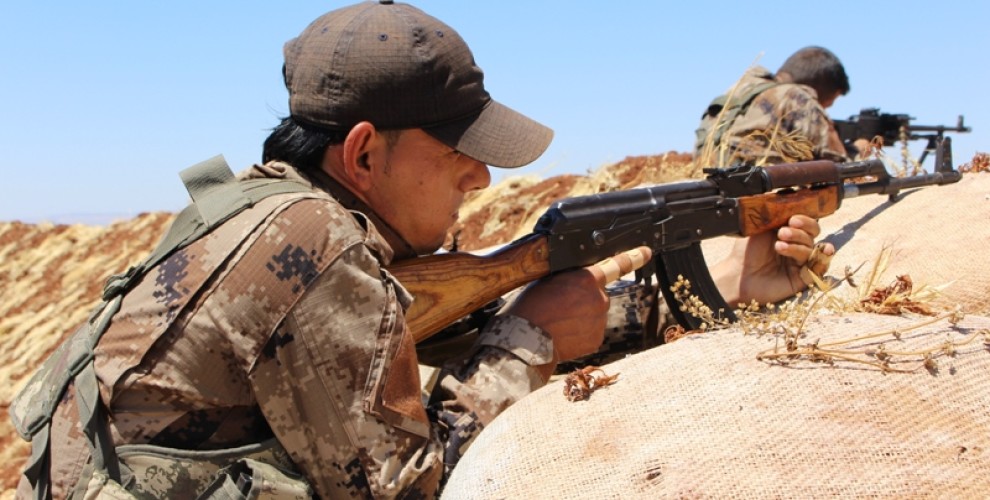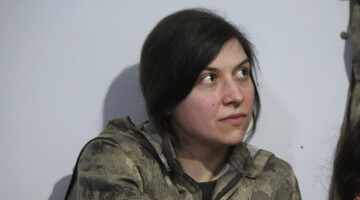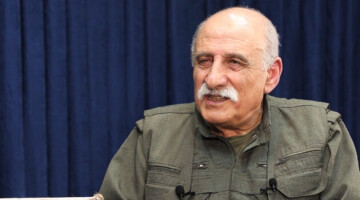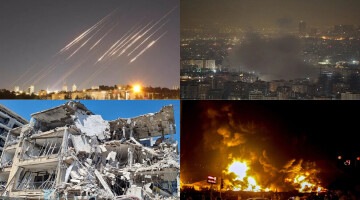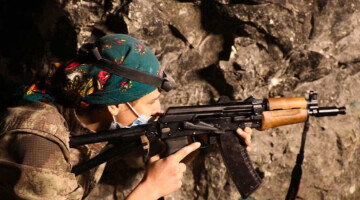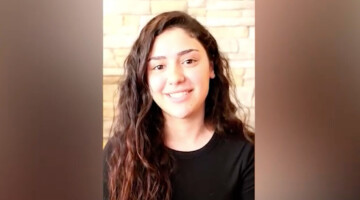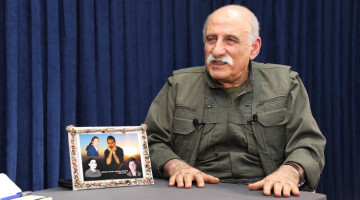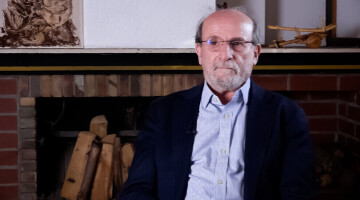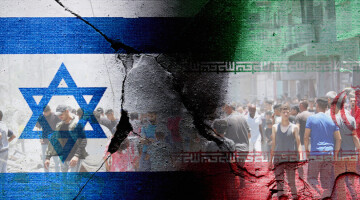Shehba consists with the main districts Azaz, al-Bab, Mare, Jabal Seman and Sifire included of dozens of towns, 800 villages and hundreds of hamlets more. From the year 2011 onwards, at the beginnings of the Syrian civil war, the attacks were always focused on this region, which became a main target of invasion and plundering.
In 2016 finally, many villages of Shehba had been liberated by the force Jaysh al-Thuwar. In those liberated areas a new life has been built up amidst ongoing bombardments and invasion attacks. This named area encompasses 75 villages and is dubbed "Free Shehba" by its inhabitants. Based on the experience learned from Efrîn, also in this region life began to blossom anew.
Shehba's population partially returned to their liberated villages and lands. But they still remain uninterruptedly under bombardment by tanks and air strikes of the Turkish state. Yet the free Shehba, which is today a vital part of the Northern Syria Democratic Federal System, is celebrating the anniversary of the Rojava Revolution defiantly in the face of invasion threats. Despite all the aggravated attacks in the last four months, the inhabitants of Shehba are persevering in their decision to remain and defend their soil on all accounts.
In this sequel writing, we will try to dive into the matters like the strategic and historical site of Shehba, the invasion attempts by the gangs and the Turkish state and the resistance put up against this invasion of Shehba.
A HISTORIC AND STRATEGIC GEOGRAPHY
To understand the tradition behind the resistance of free Shehba, it is necessary to get to know its strategic and historical location.
Shehba spans an area of 5000 km2 and a length of 90 kilometres. Shehba consists with the main towns and districts Minbic, Azaz, al-Bab, Mare, Jabal Seman and Sifire included, of dozens of towns, 800 villages and hundreds of hamlets more. The Syria's political system attaches Shehba to the federal state of Aleppo, calling it also Allepo's Shehba.
Shehba as a geography has opened its arms in the course of history to the greatest of civilizations of Mesopotamia. It harbours an ancient route reaching from the Taurus region to the Mediterranean and has earned a vital and strategic place in the trade business and expansion of civilisations.
The Shehba region, which became throughout the course of a hub of coexistence between the Kurdish, Arab, Turkmen, Circassian, Armenian and Afshar people and countless different religions and believes, has turned as time passed because of this strategic meaningfulness of it, becoming the target of invasion of many empires and states ever since. Its reign switched in following order from the Ayyubid dynasty, to the Roman Empire, the Byzantine Empire, Emewi, Abbasi, Hamdani, Mirasi, Ukayli, the Great Seljuk Empire and the Ottoman Empire. Following the fall of the Ottomans, France appeared on the stage and occupied the region, which was handed over to the Syrian state's sovereignty afterwards.
NEITHER THE OTTOMANS NOR THE BA'ATH COULD ANNIHILATE THE KURDS
From historical aspect, the entire Shehba region was home to different cultures and peoples , harbouring Kurds, Arabs, Turkmesn, Circassians, Armenians, Chechens, Assyrians, Chaldeans, Druses, Syriacs and Albanians and a variety of religions like Êzidî, Ismaili, Alawi, Sunnism, Shiism, Christianity and Judaism.
Even though the Shehba region is said to be populated today by a Kurdish minority only, it always used to be in the course of history a region dominated by the Kurdish people. But with the Ottoman Empire's invasion of the Shehba region in 1516, the status quo changed dramatically, as they initialized a merciless Turkification and Sunnification policy to change the entire demography. Taking the Ottomans an example, also the Ba'th regime adopted from 1960 onwards a policy of changing the demography of Kurdish lands and implemented the so called 'Arab belt' policy with Shehba being the first Kurdish region in Rojava to be affected. The Arab regime set up countless Arab settlements in between Kurdish villages to sever the ties of the Kurdish villages. Innumerable Kurdish villages were forcibly emptied and resettled with an Arab population.
Due to this annihilation policy, the Kurdish population in the Shehba region dropped in 2011 to 40 percent. Kurds in Shehba were furthermore forced to speak the Turkmen and Arabic languages. Even nowadays there are many Kurds, who do not know their mother tongue for this reason. However one can not assert that these annihilation and assimilation policies of the Ottomans and the Ba'ath regime have triumphed. Because despite all those dirty policies, the majority of the Kurds living in Shehba has preserved their identity nevertheless.
THE FIRST REGION TO BE ABONDONED BY THE REGIME
Prior to the outbreak of the Syrian civil war in 2011, the Syrian regime had been very influential in Shehba, which is located at the Turkish border. But as it understood that it would not be able to uphold its control over all of Syria any longer, the Ba'ath regime consequently chose to withdraw its forces to Syria's central region. As a matter of fact Shehba fell until 2012 completely into the hands of groups affiliated with the Fee Syrian Army and the Syrian National Coalition Forces. During this time the number of newly forged armed groups grew day by day constantly and ultimately gangs were set up by Turkey. This led the Kurds living in the region to organise their own defence. During the transition of the year 2011 to 2012 two defense units were set up around al-Bab.
In 2013 Turkey infiltrated the Free Syrian Army to a high degree and the Syrian side arm of the Al Qaeda, the Al Nusra emerged in the region as a new entity. In February of the same year the Jabhat al-Akrad (Kurdish Front), a sub unit within the Free Syrian Army, was proclaimed in Aleppo. The Al-Nusra gangs went over to attack the Kurdish population and the Jabhat al-Akrad. As a result of this gang's massacres, pillage raids and abductions of Kurdish civilians, a massive migration set in in the Shehba region. Kurds headed mostly to the Efrîn canton in Rojava.
THE INVASION OF ISIS
Between the Al-Nusra front and ISIS, both of whom were fed, equipped and backed by the Turkish state, conflicts and fights broke out. After a very short time the Al-Nusra gang handed over the control over the cities Manbij, and later alsoal- Bab and Jarablus to ISIS. Following this, those gangs of the Turkish state, that called themselves a part of the Free Syrian Army, only remained in Azaz, Mare and Tal Rifat.
The new occupiers, the ISIS gangs stepped up the terror and oppression on the people of Shehba. They attacked the Kurdish community more excessively than the Al-Nusra before them. It was then, when the Kurdish population left Shehba in masses.
For ISIS and its backer the Turkish state, the Shehba region and in particular the Jarablus route became important centres where they stole natural gas and crude oil.
LIBERATION OF THE SHEHBA REGIONS
Despite all these invasions and oppressions, the people of Shehba did not let go of their resistance nevertheless. Following the Al-Akrad Front, Shehba's inhabitants started to form their own forces called Jaysh al-Thuwar and Shams al-Shamal, built the Manbij Military Council and joined the Syrian Democratic Forces (SDF).
The SDF forces, represented in the local area by the Jaysh al-Thuwar, commenced a military operation in response to the attacks of the Free Syrian Army and the Turkish state between 2015 and 2016.As a result the towns Dêr Cemal, Teneb, Keştear, Merenaz, Vîllat El Qadî and El Qemiye affiliated to the Efrîn canton, the towns Til Rifet, Kefer Naya Minix, Kefer Nasih, Îhrîs, Ayn Daqnê, Beylûniye, Şêx Hîlal, Kefer Entwan, Şehabiye and Til Ecar of the Shehba region and the Military airport in Minix were liberated from the gangs of the Turkish state.
LIBERATION OF MANBIJ BECAME A HOPE FOR SHEHBA
One of the most important and decisive pages of the history of Shehba, was the liberation of Manbij. The same like the great resistance of KobanÊ became the proof that ISIS was vincible, also the liberation of Manbij from ISIS gangs flared up the hopes that the whole of Shehba could indeed be liberated as well. The Manbij Military Council, which was established on the 2nd April 2016 and comprises of 13 military units, launched the operation to liberate Manbij on the 1st June 2016 on the request of the people of Manbij and the Manbij Administrative Council. The 72 day long operation ended with support from the SDF forces on the 12th of August 2016 in the liberation of whole of Manbij from the ISIS gangs.
Shortly after the liberation of Manbij, another Military Council was formed, this time of the city al-Bab, composing of seven military units and the vow was given that also al-Bab would be cleared of the ISIS thugs. Next on the 22nd August 2016 the Military Council of Jarablus was proclaimed and the liberation of Jarablus from the ISIS gangs was pledged.
The Jaysh al-Thuwar unit of the Manbij Military Council launched its operation against the ISIS gangs in al-Bab and liberated on different occasions the villages of Um Hosh, Um Qura, Herbel, Hesiye, Semûqa, Til Qerah, Wehşiye, Fafîn, Qeramil, Til Midyeq, Qolsirûc, Hewarîn, Til Şeîr, Muşat, Kefer Qaris, Til Sosyan and Elaoşa as well as the cement factory located in the village of Til Sosyan and most importantly the Shehba Dam.
THE RED-HANDED PERPETRATOR EMERGED IN SHEHBA
The day the Jarablus Military Council was proclaimed, its commander was assassinated by the Turkish secret service MIT. After the Turkish state finally realized that its ISIS mercenary gang could no longer maintain itself in the Shehba region, Turkey itself began to invade on the 24th August 2016 Shehba over Jarablus and launched an extensive invasion operation of Northern Syria under the name of "Euphrates Shield". The ISIS gangs there handed over the city within two hours to its new occupiers, the Turkish state affiliated gangs of the Euphrates Shield without even shooting one single bullet. By this the Turkish state first secured its rule over the town Rai in early September and received later also Azaz and al-Bab settled on agreements.
The Turkish state aiming to fully invade all of Northern Syria as a whole undisguisedly starting with Shehba, bombarded and shelled many times the Efrîn canton and the freed areas of Shehba heavily. From the first day on the operation to invade Northern Syria was launched by Turkey, it systematically targeted the already liberated areas of Shehba, the emplacements of the Jarablus Military Council, Jaysh al-Thuwar and Jabhat Al- Akrad, making unmistakably clear that its main objective was nothing less than to prevent the Northern Syria Democratic Federal System Project from accomplishing.
The Jarablus Military Council however did not hold back and responded forcefully, leading to a two days long heavy battle. After the fightings threatened to escalate, the US intervened, but had its implemented ceasefires violated several times by the Turkish state and its gangs.
Furthermore the Turkish state and its gangs kept on shelling from the direction of al-Bab the positions of the Jaysh al-Thuwar forces located in liberated areas, but were left empty handed nevertheless.
Since February they are attacking and bombarding the Manbij Military Council from the occupied areas in al-Bab with all their force. Yet following the agreements the Manbij Military Council signed with the international forces, Turkey was forced to halt its attacks and declared on the 30th of March 2017 the "Operation Euphrates Shield" ended. Its ongoing presence in the Shehba area however is the continuation of its invasion of Northern Syria.
Despite all backlashes and the ongoing operation to liberate Raqqa led by the SDF forces, the Turkish state has put the invasion of the entire Shehba region and the Efrîn canton once again on its agenda and has increased its bombardments and attacks. The People's Defense Units (YPG) and the Revolutionary Forces are creating fiercely against those attacks a bulwark.
The peoples of Shehba and Efrîn Canton are determined to resist against the Turkish state and the gangs on all accounts.

